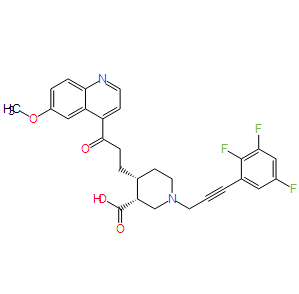| Description: |
RPR260243 [(3R,4R)-4-[3-(6-methoxy-quinolin-4-yl)-3-oxo-propyl]-1-[3-(2,3,5-trifluoro-phenyl)-prop-2-yn-1-yl]-piperidine-3-carboxylic acid] was the first reported hERG channel activator. RPR260243 dramatically slows current deactivation in patch-clamp experiments, and its effect is temperature and voltage dependent. Though it is a weak inhibitor of the L-type Ca2+ channel, RPR260243 has no significant effects on the human cardiac Na+ channel or the KCNQ1/KCNE1 cardiac K+ channel, which are also linked with LQTS, thus showing high selectivity for hERG. Interestingly, RPR260243 inhibits the erg3 channel, which is in the same family as hERG, and a single S5 residue may account for this difference in pharmacology (Thr556 in hERG, Ile558 in rERG3). A Thr in this position favors agonist activity, whereas an Ile reveals a secondary blocking effect of RPR26024323. Additionally, RPR260243 enhances the delayed rectifier current in guinea pig myocytes and can, to some extent, reverse dofetilide-induced prolongation of action potential. Physiologically, it has been reported that RPR260243 can increase the T-wave amplitude, prolong the PR interval and shorten the QT interval in guinea pig hearts.
For the detailed information of RPR-260243, the solubility of RPR-260243 in water, the solubility of RPR-260243 in DMSO, the solubility of RPR-260243 in PBS buffer, the animal experiment (test) of RPR-260243, the cell expriment (test) of RPR-260243, the in vivo, in vitro and clinical trial test of RPR-260243, the EC50, IC50,and affinity,of RPR-260243, For the detailed information of RPR-260243, the solubility of RPR-260243 in water, the solubility of RPR-260243 in DMSO, the solubility of RPR-260243 in PBS buffer, the animal experiment (test) of RPR-260243, the cell expriment (test) of RPR-260243, the in vivo, in vitro and clinical trial test of RPR-260243, the EC50, IC50,and affinity,of RPR-260243, Please contact DC Chemicals. |






















